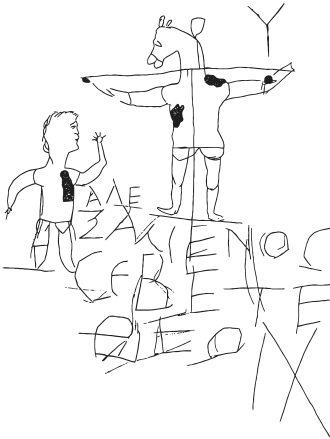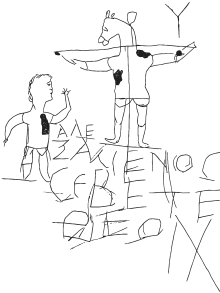TheHolyBookEnds
Well-Known Member
If I do not "know" the Father and Jesus Christ whom He has sent, then I know nothing, no matter what else I 'know' (vanity).You know too much!
I never heard of the above, but I know it's not true.
Jesus was always depicted on a stake with a cross beam,,,that's why it's called a cross. And was from the beginning, as church history shows.
What I'm trying to understand is WHY the WTS would think this is so important.
The very word "cross" means that something was crossed with something else.
I'm posting the attached to save time since I don't have much today....
Jesus Himself and the writers of the N.T. spoke of this cross...
https://earlychristianbeliefs.org/early-christian-view-cross/
If you would, tell me why the JW's think it's an important point.
However, the WTS/JW proclaim that the Cross is pagan, and therefore, God would never use that. They willingly forget that paganism always twists the reality, and the cross is the symbol of the love to God and man, vertical and horizontal, the cross-roads of love. There is more to it than this, but they do not acknowledge all of the pagan material in their own writings, the Winged sun disk of Thebes, 3 finger hands, keys, and all else. They also do not seem to realize that the "stake" (upright pole) is just as "pagan", look around the world. The upright pole is all over the place in "paganism", and so they practice hypocrisy.
However, Jesus died upon the "Cross". It is from OT to NT, not merely in English language, but in type and antitype, in prophecy and all over. However, let me go back to show you what the WTS/JW left out from the Imperial Bible Dictionary and the Roman Catholic Encylopedia.
Again, here is what they said it says:
"... The Imperial Bible-Dictionary says that the word staurosʹ “properly signified a stake, an upright pole, or piece of paling, on which anything might be hung, or which might be used in impaling a piece of ground.” The dictionary continues: “Even amongst the Romans the crux (Latin, from which our cross is derived) appears to have been originally an upright pole.” Thus, it is not surprising that The Catholic Encyclopedia states: “Certain it is, at any rate, that the cross originally consisted of a simple vertical pole, sharpened at its upper end.” ..." - [1]
Here is the actual source in what it really says (and notice where they stopped and used ellipses):
"... CROSS, CRUCIFY. The Greek word for cross, σταυρός, properly signified a stake, an upright pole, or piece of paling, on which anything might be hung, or which might be used in impaling a piece of ground. But a modification was introduced as the dominion and usages of Rome extended themselves through Greek-speaking countries. Even amongst the Romans the crux (from which our cross is derived) appears to have been originally an upright pole, and this always remained the more prominent part. But from the time that it began to be used as an instrument of punishment, a transverse piece of wood was commonly added: not, however, always even then. For it would seem that there were more kinds of death than the one by the cross; this being sometimes accomplished by transfixing the criminal with a pole, which was run through his back and spine, and came out at his mouth (adactum per medium hominem, qui per os emergat, stipitem, Seneca, Ep. xiv.) In another place (Consol. ad Marciam, xx.), Seneca mentions three different forms: "I see," says he, "three crosses, not indeed of one sort, but fashioned in different ways; one sort suspending by the head persons bent toward the earth, others transfixing them through their secret parts, others extending their arms on a patibulum." There can be no doubt, however, that the latter sort was the more common, and that about the period of the gospel age crucifixion was usually accomplished by suspending the criminal on a cross piece of wood.
But this does not of itself determine the precise form of the cross; for crosses of three different shapes were known to have been in use. One, and that probably the most ancient, was in the form of the letter T, which as commonly written consisted simply of a perpendicular line with another laid across the top, making two right angles, T. In the earlier Christian writers this letter is often referred to to as a symbol of the cross, and, on account of such a resemblance, Lucian, in his usual style, prefers a charge against the letter (Judio. Voc. xii.) The letter X represents another sort, which has received the name of St. Andrew, from a tradition that on a cross of this description the apostle of that [376-377] name suffered martyrdom. But the commonest form, it is understood, was that in which the upright piece of wood was crossed by another near the top, but not precisely at it, the upright pole running above the other, thus t -- and so making four, not merely two right angles. It was on a cross of this form, according to the general voice of tradition, that our Lord suffered; but there is nothing in the narratives of the evangelists which determines this to have been the form employed, rather than either of the other two. It is, however, the one most commonly met with in the paintings and sculptures that have survived from the earlier ages. …" - The Imperial Bible Dictionary, Historical, Biographical, Geographical, and Doctrinal: Including the Natural History, Antiquities, Manners, Customs, and Religious Rites And Ceremonies Mentioned In The Scriptures, And An Account Of The Several Books Of The Old And New Testaments. Edited By The Rev. Patrick Fairbairn, D.D., Author Of "Typology Of Scripture," "Commentary On Ezekiel," Etc. Illustrated By Numerous Engravers, Volume I, London: Blackie And Son, Paternoster Row; And Glasgow And Edinburgh. MDCCCLXVL., pages 376, 377 - https://archive.org/stream/imperialbibledi00fairgoog#page/n402/mode/1up/search/"an+upright+pole"
I shall cite the Roman Catholic Encyclopedia next, and notice what they purposefully left out of it.
Last edited by a moderator:




